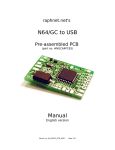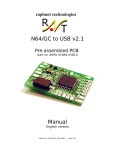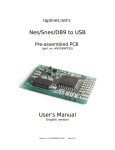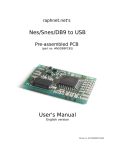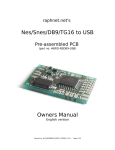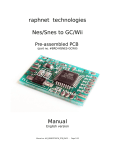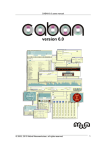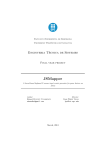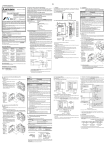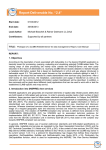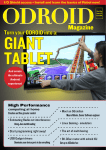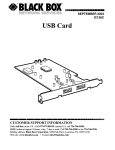Download raphnet.net`s Nes/Snes/DB9 to USB
Transcript
raphnet.net's USB Game12 (4 directions + 8 buttons to USB) Pre-assembled PCB (part no. #USBGAME12PCB1) Manual English version Manual no. #M_USBGAME12_PCB_ENG1 - Page 1/11 Table of Contents 1) Introduction.........................................................................................................3 1.1) Product summary..........................................................................................3 1.2) Supported operating Systems.......................................................................3 2) Getting started....................................................................................................3 2.1) What you should have received....................................................................3 2.2) Required equipment (not included)..............................................................4 2.3) Recommended equipment............................................................................4 2.4) Recommended installation steps..................................................................4 3) Assembly.............................................................................................................5 3.1) Soldering USB wires......................................................................................5 3.2) Button/Controller wiring................................................................................6 3.3) Arcade controller wiring example.................................................................7 3.4) NeoGeo.........................................................................................................8 4) Installation...........................................................................................................9 4.1) Installation under Windows...........................................................................9 4.2) Installation under Mac OS X..........................................................................9 4.3) Installation under Linux..............................................................................10 5) Copyright, Disclaimer and History.....................................................................11 5.1) Copyright....................................................................................................11 5.2) Disclaimer...................................................................................................11 5.3) Revision history...........................................................................................11 Manual no. #M_USBGAME12_PCB_ENG1 - Page 2/11 1) Introduction 1.1) Product summary This small circuit has a total of 12 inputs (4 directions and 8 buttons) and connects to an USB port, implementing a standard USB Hid joystick. Potential applications: ● Small arcade cabinets ● Arcade style controllers ● Adaptation of simple (passive switches) controllers to USB (eg: Neo Geo, Atari, SMS) ● Custom buttons on computer cases 1.2) Supported operating Systems Many operating systems support USB HID joysticks. This product is known to work with at least the following operating systems: ● Linux kernel 2.4 and 2.6 ● Mac OS X ● Microsoft Windows 98/ME ● Microsoft Windows 2000/XP/Vista 2) Getting started 2.1) What you should have received 1. One PCB with 10 components installed on the Top layer, and 2 installed on the bottom layer. Bottom layer Top layer Manual no. #M_USBGAME12_PCB_ENG1 - Page 3/11 2.2) Required equipment (not included) 1. Soldering equipment. 2. Basic electronic tools. (cutters, wire stripper, tweezers) 3. Multimeter for testing continuity. 4. USB cable with an USB male connector (type A) on one side, and bare wires at the opposite side. You may cut a cable in two parts to obtain this. 5. If you plan to build an adapter (instead installing the circuit inside a controller), you will need a connector that mates with your controller. This can come from an extension cord, a (broken) console, or an electronic component store. 6. Also if building an adapter, some kind of enclosure to protect the circuit is highly recommended. This is especially important to prevent the circuit from coming in contact with anything metallic such as a computer case. This could cause a short circuit which could likely cause damages to the circuit and/or your computer, depending on circumstances. 2.3) Recommended equipment 1. Desoldering braid (just in case) 2. Hot glue gun and Hot glue (to prevent the wires from eventually breaking at the point where they are soldered). Especially important if the wires may move. 2.4) Recommended installation steps 1. Start by carefully planning how you will install the circuit inside the controller (or your enclosure). Make sure you dont cut the wires too short and that the circuit will not be in the way when you put back the cover. 2. Install the USB wires (see Chapter 3, section 1) 3. Install your controller wires (see Chapter 3, section 2 and 3) 4. Inspect for shorts. Double-checking with a multimeter is recommended if you have any doubts. 5. Test on a computer. This must be done with a controller installed. Otherwise, the adapter just keeps waiting for a controller and will not be detected by the computer. 6. Pour hot glue over the solder points. 7. Insulate any metal part (e.g. USB cable shield) which could come in contact with the Circuit. Use electric tape or hot glue. 8. Finish the installation. (Close enclosure) 9. Play! Manual no. #M_USBGAME12_PCB_ENG1 - Page 4/11 3) Assembly 3.1) Soldering USB wires The USB standard dictates the color code that shall be used inside an USB cable. This means that normally, all you need to do is to solder the wires exactly as they are on the picture. The White wire should be soldered to the pad labelled W, the green wire to the pad labelled G, the black wire to the pad labelled – (minus), and the red wire to the pad labelled + (plus). Warning: Some rare USB cables dont follow the standard color code. If the cable you use has additional wires, if any color is different, or if you have doubts, check the pinout with a multimeter. Mis-wiring may cause damage to your computer, to this circuit or to the controller. Here is the standard USB pinout Pin 1 Red 5 volts Pin 2 White D- Pin 3 Green D+ Pin 4 Black Ground Manual no. #M_USBGAME12_PCB_ENG1 - Page 5/11 3.2) Button/Controller wiring ➢ This circuit is meant to be used with Normally open buttons. (In other words, buttons must conduct electricity only when pressed). ➢ As soon as an input becomes connected to or disconnected from 'Common' (due to a button press or release), the circuit sends the event to the computer via the USB connection. ➢ The 5 volts output shown in the diagram above may be used if you need a 5 volt source (50mA max). You can use it for LEDs (with proper resistors) or for powering a controller. (some NeoGeo controllers, for instance, need power to work). ➢ Buttons 5 to 7 are a little harder to solder. Pre-tinning the solder points on the PCB and the wires (small wires) should greatly ease soldering. But this tip applies to all connections. Manual no. #M_USBGAME12_PCB_ENG1 - Page 6/11 3.3) Arcade controller wiring example All buttons are normally open (NO). Manual no. #M_USBGAME12_PCB_ENG1 - Page 7/11 3.4) NeoGeo controller wiring Neo Geo controlers uses standard DB15 connectors. This connector is also used by old PC Joysticks but it incompatible. Here's a table describing how to wire a Neo Geo controller connector to this circuit: DB15 pin Neo Geo name USBGame12 name Comments 1 Common Common 3 Select Button 5 4 D Button Button 3 5 B Button Button 1 6 Right Right 7 Down Down 8 +5v 5 volts Only for some controllers. 9 D button Button 3 Duplicates pin 4. 11 Start Button 4 12 C button Buton 2 13 A button Button 0 14 Left Left 15 Up Up (DB15 pin 2 and 10 are not connected) Manual no. #M_USBGAME12_PCB_ENG1 - Page 8/11 4) Installation Up to now, all operating systems this product was tested with had native support for USB HID joysticks and gamepads. Most of the time, connecting the adapter is all that has to be done before starting your game. (and then of course, you configure the game to use joysticks). But here are a few installation notes for different operating systems. 4.1) Installation under Windows When you connect the adapter for the first time, depending on your Windows version, a pop up may appear requesting that you insert your windows installation cdrom. Follow the instructions. After installation completes, you may have to reboot your computer. Once the drivers are installed, the controller should appear in Control Panel -> Game controllers/ Gaming options every time you connect the adapter. 4.2) Installation under Mac OS X No installation instruction at the moment. No drivers are required, but the game or emulator you use must support USB Joysticks. You may use USB Prober to check for the device presence. USB Prober Manual no. #M_USBGAME12_PCB_ENG1 - Page 9/11 4.3) Installation under Linux Normally, the controller will work instantly. There are too many different Linux distributions to cover every possible scenarios, but here are a few ways to check if the adapter was detected correctly. After connecting your adapter, check dmesg for a message such as this one: [772418.107227] usb 1-2.4: new low speed USB device using uhci_hcd and address 91 [772418.239325] usb 1-2.4: configuration #1 chosen from 1 choice [772418.265276] input: raphnet.net USB_Game12 as /class/input/input9 [772418.265332] input: USB HID v1.01 Gamepad [raphnet.net USB_Game12] on usb-0000:00:1a.0-2.4 Make sure the usb, input, hid and joydev modules are loaded (or compiled into your kernel). The device should appear /proc/bus/input/devices: # cat /proc/bus/input/devices ... I: Bus=0003 Vendor=1781 Product=0a96 Version=0101 N: Name="raphnet.net USB_Game12" P: Phys=usb-0000:00:1a.0-2.4/input0 S: Sysfs=/class/input/input9 U: Uniq=3107 H: Handlers=event3 js0 B: EV=b B: KEY=ffff0000 0 0 0 0 0 0 0 0 0 B: ABS=7b Notice the 'js0' handler above. If you have more than one controller, this could be js1, js2... If no jsX handler is present, you need the joydev module. In order to test the buttons and directions, you can use the jstest tool. Under Debian, this is in the joystick package. # jstest ./js0 Driver version is 2.1.0. Joystick (raphnet.net raphnet_joy) has 2 axes (X, Y) and 8 buttons (BtnX, BtnY, BtnZ, BtnTL, BtnTR, BtnTL2, BtnTR2, BtnSelect). Testing ... (interrupt to exit) Manual no. #M_USBGAME12_PCB_ENG1 - Page 10/11 5) Copyright, Disclaimer and History 5.1) Copyright All the information, pictures, diagrams, tables and texts contained in this manual is Copyright © 2007-2008 Raphaël Assénat. All rights reserved. Partial or total reproduction is not permitted without the Copyright holder's written authorisation, except for personal use. Trademarks that are mentioned in this manual are the property of their respective owners. 5.2) Disclaimer Even though I made great efforts and a lot of testing to make sure my products are safe, I cannot be held responsible for any damage(s) or loss(es) caused directly or indirectly by the use of my products, including but not limited to, loss of data, loss of profit, computer/server downtime, device and peripheral damage or failure. While I believe that all the information contained in this manual is accurate, should any damage(s) occur due to error(s) in this manual, my responsibility will be limited to replacing my product if it is damaged. 5.3) Revision history February 01, 2008 First version of this manual. Manual no. #M_USBGAME12_PCB_ENG1 - Page 11/11











